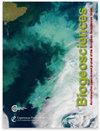综述与综合:铁-土壤氮生物有效性的驱动因素?
IF 3.9
2区 地球科学
Q1 ECOLOGY
引用次数: 1
摘要
摘要充足的生物有效氮(N)供应对土壤微生物群落和植物至关重要。在过去的几十年里,与土壤质地、pH值和有机质(OM)等其他因素相比,研究工作很少考虑到活性铁(Fe)矿物在土壤中产生或消耗生物可利用氮的过程中的重要性。然而,铁参与影响N循环的酶促和非酶促反应。更广泛地说,活性铁矿物通过吸附过程限制土壤有机质(SOM)循环,但也促进SOM在缺氧条件下的分解和反硝化。通过综合现有研究,我们发现铁在氮的生物利用度中起着不同的作用。铁通过作为吸附剂、催化剂和电子转移剂直接影响氮的生物有效性,或通过促进影响氮周转过程的某些土壤特征(如团聚体的形成和稳定性)间接影响氮的生物有效性。根据干湿循环过程中土壤氧化还原变化等环境条件的不同,这些作用可能导致氮生物利用度的不同结果。我们提供了Fe-N相互作用的例子,并讨论了可能的潜在机制,这些机制可以是非生物的或微生物的。我们还讨论了铁如何参与影响氮生物利用度的三种复杂现象:启动、桦树效应和冻融循环。此外,我们强调了铁-氮生物利用度相互作用如何受到全球变化的影响,并确定了方法学上的限制,这些限制阻碍了铁在控制氮生物利用度方面的机制理解的发展,并强调了需要研究的领域。本文章由计算机程序翻译,如有差异,请以英文原文为准。
Reviews and syntheses: Iron – a driver of nitrogen bioavailability in soils?
Abstract. An adequate supply of bioavailable nitrogen (N) is critical to soil microbial communities and plants. Over the last decades, research efforts have rarely considered the importance of reactive iron (Fe) minerals in the processes that produce or consume bioavailable N in soils compared to other factors such as soil texture, pH, and organic matter (OM). However, Fe is involved in both enzymatic and non-enzymatic reactions that influence the N cycle. More broadly, reactive Fe minerals restrict soil organic matter (SOM) cycling through sorption processes but also promote SOM decomposition and denitrification in anoxic conditions. By synthesizing available research, we show that Fe plays diverse roles in N bioavailability. Fe affects N bioavailability directly by acting as a sorbent, catalyst, and electron transfer agent or indirectly by promoting certain soil features, such as aggregate formation and stability, which affect N turnover processes. These roles can lead to different outcomes in terms of N bioavailability, depending on environmental conditions such as soil redox shifts during wet–dry cycles. We provide examples of Fe–N interactions and discuss the possible underlying mechanisms, which can be abiotic or microbially meditated. We also discuss how Fe participates in three complex phenomena that influence N bioavailability: priming, the Birch effect, and freeze–thaw cycles. Furthermore, we highlight how Fe–N bioavailability interactions are influenced by global change and identify methodological constraints that hinder the development of a mechanistic understanding of Fe in terms of controlling N bioavailability and highlight the areas of needed research.
求助全文
通过发布文献求助,成功后即可免费获取论文全文。
去求助
来源期刊

Biogeosciences
环境科学-地球科学综合
CiteScore
8.60
自引率
8.20%
发文量
258
审稿时长
4.2 months
期刊介绍:
Biogeosciences (BG) is an international scientific journal dedicated to the publication and discussion of research articles, short communications and review papers on all aspects of the interactions between the biological, chemical and physical processes in terrestrial or extraterrestrial life with the geosphere, hydrosphere and atmosphere. The objective of the journal is to cut across the boundaries of established sciences and achieve an interdisciplinary view of these interactions. Experimental, conceptual and modelling approaches are welcome.
 求助内容:
求助内容: 应助结果提醒方式:
应助结果提醒方式:


